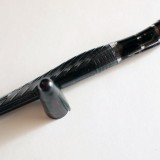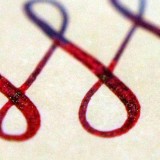Word 2007 for Writers: Part 4 – Fun with Sections
Chances are, you’ve learned how to insert page breaks into Word documents (Insert > Page Break, just in case). This is useful for, say, adding a “Works Cited” page at the end of a document.
But you might have seen another kind of “break” while moving through Word’s menus. They’re in a different place for some reason — go to the Page Layout tab and look at the “Page Setup” section and you’ll see a drop-down marked “Breaks”. Here you’ll find several different ways to insert section breaks:
- Next page: Inserts a section break and moves you to the next page. Useful for starting a new chapter.
- Continuous: Inserts a section break but keeps you on the same page. Useful when writing copy that you don’t know the end-formatting for, such as something that will eventually end up as a sidebar.
- Even Page: Inserts a section break and jumps you to the next even page. Useful for booklets.
- Odd Page: Inserts a section break and jumps you to the next odd page. Useful for book layouts, where you always want the chapters to start on the odd (right-hand) page.
A section is more than just a page break, though. What makes them especially powerful is that you can apply styles to each section individually.
Let’s say, for instance, that you want to include an appendix in your book, but you’d like the text to be smaller than the rest of the book, and all the headings and indented quotes and everything else to be scaled accordingly. You can define a new style for the appendix with smaller font sizes for every element, and apply it only to that section. This is incredibly useful for bibliographies, where, for instance, you might want to use hanging paragraphs (where the first line is aligned to the margin but all subsequent lines are indented one or two tabs).
The options for working with sections don’t stop at styles, though. In fact, just about everything you can customize for a document as a whole you can customize individually for each section within a document. It’s as if you were stringing together several documents, each with its own style sheet.
So your cover page can be styled one way, your front matter another, your body chapters a third, your index a fourth, and so on. Each section can be individually paginated, which means you can have no page numbers on your cover page(s), lowercase Roman numerals (i, ii, iii, iv…) on your preface and introduction pages, and traditional numbering on all your chapters. (Go to “Insert > Page Numbers > Format Page Numbers” and check or uncheck the “Continue from Previous Section” option as needed.)
Other things you can do with sections:
- Insert a page in landscape layout: Set your cursor in the section you want to change the layout of, go to “Page Layout > Orientation” and choose “Landscape”.
- Insert a multi-columned page or pages: Again, set your cursor in the section you want to reformat, go to “Page Layout > Columns” and select the column layout you want.
- Remove section breaks: On the Home tab, click the “Paragraph” button (the one that looks like a backwards “P” — the popup says “Show/Hide”) to show all the layout codes in your document. Set your cursor before a section break and hit “Delete”.
Sections + Styles = Table of Contents
Here’s something neat you can do with longer documents. Assuming you’ve been good with applying styles — Heading 1 for chapter titles, Heading 2 for chapter sections, etc. — you can have Word automatically generate a Table of Contents. For some reason this is under “References”.
Create a new section near the front of your document (duh, right?). Set your cursor at the top, and click the “Table of Contents” button on the “References” tab. You can select one of the pre-defined styles, or you can click “Insert Table of Contents” to bring up a dialog to adjust the settings.
Decide how many levels you want to appear in your table of contents — if you want just the chapter titles, select “1”, for chapter titles and sub-heads, select “2”, to add sub-sub-heads select “3”. It will use your “Heading 1” text for the first level, “Heading 2” for the second, “Heading 3” for the third — creating an outline of the book based on your styled text. Pretty neat, huh?
Up next: a grab-bag of proofreading and editing tricks in Word 2007. Stay tuned, as always!






Dear genius of Word 2007.
I have written a book!!!!!!!! It has sevenseparate chapters. The chapters have to be kept separate from each other because each chapter has up to thirty footnotes or more. Putting the chapters together would create over 180 numbered footnotes beginning with 1 and ending with 180 or more.
I can generate the table of contents for each chapter. That is not a problem. But I cannot collect the separate TOC for each chapter together to create a unified TOC for the whole bnook without the following appearing where the page numbers should be: MISTAKE! TEXT MARK NOT DEFINED (Fehler! Textmarke nicht definiert!) (I am using a German version of Word 2007.)
Can anyone help me?
Please answer as soion as possible.
SALVE
SALVE: You can do this with a Master Document — you might have to move some stuff around in your source documents, though. Another option is to use Chapter by Chapter (info here: http://www.writerstechnology.com/2008/09/software-for-writers-chapter-by-chapter) which is intended to smooth out some of the rough edges Word;s Master Document feature still has.
I have had Word 2007 only a few weeks. Today I tried to insert page breaks after each page in my ms so I could email it to an editor as she was afraid we might have trouble discussing it unless we locked in the page numbers. I started at the bottom of page 1. When I hit ‘page break’ from the page layout menu, all hell broke loose! It changed some of the nearby double spaced lines to single, left a half-page of white space after the page break, took part of an italicized section out of italics (just one sentence). In other words it messed up the formatting. I tried the bottom of the second page – same thing. Any suggestions? (I just emailed the ms as it was in the end and it seemed to arrive formatting intact). In case it’s relevant, the text was old stuff, brought into Word 2007 from 2003 and some even earlier. Thanks for any help you can give!
Tina: I’m not sure what happened — that sort of thing has been a long-standing issue with Word, mostly because sometimes you end up nesting codes that want to do different things, and there’s no easy way to address the code directly. (Maybe you remember WordPerfect 5.5 so many years ago, where you’dreveal the code to get precision placement?)
Inserting manual page breaks seems like a harsh and awkward way to do what you want, anyway. But I’ve never had an editor ask that of me, so I’ve never even thought about how to do it… If the document doesn’t need to be edited, and you just want to share it, the thing to do is expoert it as a PDF — download and install the free OFfice Add-In “Save to PDF” and you’ll get a PDF option in your Save As dialog: http://www.microsoft.com/downloads/details.aspx?FamilyId=F1FC413C-6D89-4F15-991B-63B07BA5F2E5&displaylang=en
One way to deal with those “weirdisms” in Word is to copy and paste the whole document into a new document — often this clears out the little bit of buggy whatever that’s causing the problem. Beyond that, I really don’t know… (Sorry!)